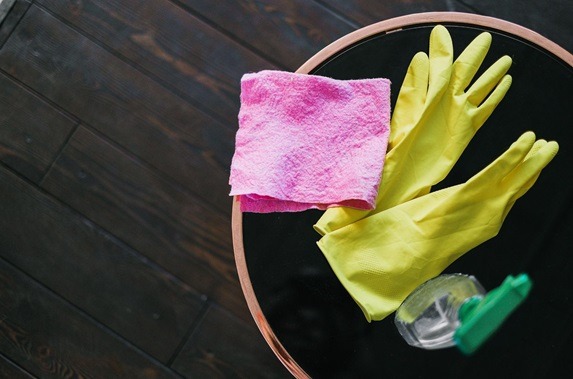Cleaning a bathroom seems simple, but getting it absolutely spotless is quite the task. We should ensure that the bathrooms of our house are cleaned not just properly, but also regularly. Wiping down the surface is not sufficient to prevent bacteria growth. These microorganisms may indirectly affect the bathroom user’s health.
As a basic rule, few important cleaning tasks should be done once a week. Some bathrooms even require frequent or daily scrubbing, based on how much it is used.
We dread cleaning the bathroom because of the thought that it will be unhygienic and filthy. But if you regularly clean your bathroom, it will never get that dirty.
One can simplify their bathroom cleaning routine, by taking time out for small cleaning sessions. This will aid to keep your bathroom clean by only spending five to ten minutes. Then, if required, you can do one big clean of around 45 minutes, every few weeks.
Read on to learn the most helpful ways to clean bathroom fixtures, including sinks, faucets, showerheads, and other bathroom fixtures.
1. Process of cleaning a Bathroom Sink
Upon entering a bathroom, the sink is the first thing we see. A bathroom sink that’s always wet has more chances of building up germs. This is why it should be kept clean at all times.
According to this bathroom cleaning guide for improvement and remodelling, the following solutions can be used to clean a bathroom sink.
- A general-purpose spray cleaner or a vinegar and water mixture (one cup vinegar to one one cup water ratio) should be used for cleaning.
- If the build-up is not very harsh, non-abrasive cleaners should be utilized, to not damage the sink polish.
- Powder needs to be applied directly to the stains, once we wet the surface. If the grime is stubborn, a mildly abrasive cleanser or a paste containing baking soda and water can be utilized to scrub the bathroom sink.
- Soap scum can be removed by cleaning with vinegar. A sponge or microfiber cloth can also be utilized to dry the sink to keep it clean .
- If the sink is the vanity type, more effort is required to clean its every corner. If it’s a pedestal, it can be comparatively easier to wipe down.
2. Process of cleaning a Bathroom Faucet
Typically a soap dish, water, and a cleaning cloth are all that you need to clean a bathroom faucet. Nevertheless, refer to the manufacturer’s instructions to identify the recommended cleaning method and tools for your faucet’s material.
Only water and a soft cloth should be utilized to clean certain finishes, such as oil-rubbed bronze or unlacquered brass. Stiff-bristled brushes or abrasive sponges should be avoided while scrubbing some finishes, such as chrome or stainless steel.
Upon cleaning the surface, a clean and dry cloth should be utilized to buff the shine and prevent water spots. If the faucets are automatic, special care must be taken while cleaning the sensors.
You can clean the bathroom faucet by spraying an all-purpose cleaner on the faucet. Try cleaning your bathroom faucet with a solution of 1 cup vinegar to 1 cup water, applied with a cleaning cloth. Alternatively use baking soda with a few drops of water for tough grime.
3. Process of cleaning a BathTub
A general-purpose cleaner, vinegar and water mixture, or a baking soda and water paste can be used to clean porcelain or ceramic bathtubs. A stain-removing cleanser should be used on rust.
Hard water stains and soap scum can lead to surface stains. An absorbent cloth can be used to dry the tub after every use to avoid staining.
4. Process of cleaning Showerheads and Faucets
To remove lime from showerheads made of chrome, stainless steel, or other protected material surfaces, plastic bags filled with white vinegar should be used. The bag should be attached to the showerhead with a rubber band. After an hour, the bag of vinegar should be removed and the shower should be turned on to flush away the vinegar and sediments.
Automatic bathroom faucets and showers should be polished with a soft cloth.
Water should be used for cleaning fixtures with oil-rubbed bronze or living finishes or brass finishes. The manufacturer’s care instructions should be referred to as some cleansers can damage a specialty surface.
5. Process of cleaning the toilet and toilet bowl
A general-purpose cleaner or a mixture of vinegar and water should be used to clean the toilet.
An all-purpose cleaner or an Ammonia and Lemon based solution can be utilized to scrub the inside or outside of a toilet with the help of a toilet brush.
The surface of the toilet seat can be cleaned with the help of a mild cleaner such as a dish soap accompanied with water. An Antibacterial toilet cleaner or one-fourth cup bleach to one gallon of water should be used to sanitize the bowl by scrubbing.
6. Process of cleaning a bathroom floor
The bathroom floor can be swept with a damp cloth. Alternatively, a vacuum cleaner can be used to clean the dry dust and hair accumulation. The bathroom floor can be cleaned in a trice by utilizing just a small quantity of baking soda for scrubbing. Some experts also suggest using a paste of bleach and baking powder to help clean the grout between tiles.
Conclusion
A proper cleaning routine needs to be maintained to ensure that you have a healthy home. To keep your bathroom spotless, the above tips should be used. The growth of germs and the spread of harmful bacteria can be stopped by doing deep cleaning daily. To stay healthy and safe, you need to take the time to properly clean your bathroom. For more details, you can head out to oltsw.com and find all the answers to your queries!

